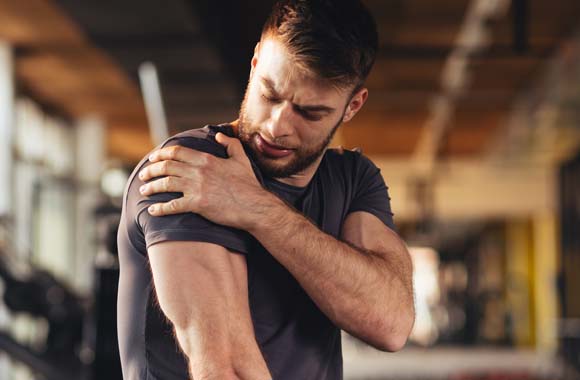SLAP tears often develop as a result of a sports injury, typically in athletes who compete in sports that require repetitive overhead motions, such as baseball, tennis, or volleyball. A SLAP tear may also be caused by sudden trauma, falling on an outstretched arm, or the natural aging process.

Symptoms of a SLAP Tear
When injured, a torn labrum can cause a partial or complete shoulder dislocation, as well as a considerable amount of pain. Some other signs that you may be experiencing a SLAP tear include:
- Locking or popping sensation
- Decreased shoulder strength
- Limited mobility
- Increased pain with overhead motions
Diagnosing a SLAP Tear
The presence of the above symptoms likely indicates a SLAP tear, but it is important to rule out other injuries and identify the extent of your tear. Your orthopedic specialist at Motion Orthopaedics will diagnose a SLAP tear by conducting a physical examination to determine arm strength, areas of tenderness, and range of motion. To confirm an accurate diagnosis, your physician is also likely to order one or more of the following tests:
- X-ray: provides images of dense structures, can identify the presence of bone spurs or arthritis
- Ultrasound: employs sound waves to produce images
Magnetic resonance imaging (MRI): uses radio waves to display shoulder structures, can display a tendon tear with highly detailed images
SLAP Tear Treatment
Nonsurgical Treatment
In most cases, your orthopedic team at Motion will initially recommend nonsurgical treatment upon diagnosis of a SLAP tear. Nonsurgical options include:
- Activity modification: to limit overhead motions
- NSAIDs: over-the-counter anti-inflammatory drugs like ibuprofen and aspirin to reduce pain and swelling
- Physical therapy: to strengthen the shoulder joint
- RICE: rest, ice, compression, and elevation
- Corticosteroid injections: relieves inflammation in the joint
However, surgical intervention may be the optimal line of treatment for you, depending on the size of your tear, the presence of other injuries, and how active your lifestyle is.
Surgical Treatment
A SLAP repair is usually performed as an arthroscopy, which is a surgical technique that primarily uses an arthroscope to examine the interior of the joint. As a specialized type of endoscope, an arthroscope is attached to a fiber-optic video camera that can easily be inserted through the skin and soft tissues by a very small surgical cut. After inserted, the view from the fiber-optic technology is transmitted to a high-definition video monitor.
Once your orthopedic surgeon can view the interior of the joint, they will be able to identify the SLAP tear and then remove the torn portion of the tendon or reattach the labrum to the bone using sutures. With an arthroscopy procedure, there are shorter recovery times and less muscle and tissue damage to the region. However, you will still be required to wear a sling for up to six weeks following your procedure to mobilize the joint.

